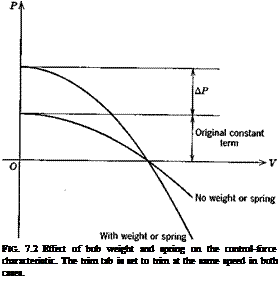EFFECT UPON CONTROL FORCE TO TRIM AND h’„

The added constant term in the control force will produce a change in the characteristic as shown in Fig. 7.2. The figure illustrates the case where the
trim tab is set to produce the same trim speed as when the ДР is absent. The parabolic part of the variation is different for the two cases (see 6.8,9) because of the altered trim-tab setting. It is clear from the figure that the net result of adding the ДР and moving the tab is to produce a steeper gradient at the given trim speed. Now the gradient has been shown in Sec.
6.9 to depend on the control-free static margin (h’n — h). Thus the increased gradient corresponds to an apparent backivard shift of the control-free neutral
point. The same conclusion is reached by consideration of the constant term of (6.8,9), which is proportional to (h’n — h). The apparent shift of the neutral point may be calculated directly from it, i. e.
or
![]() А АР a’b2 GSecew
А АР a’b2 GSecew
The term “apparent shift” of the N. P. is used above because the N. P. location depends on G’l and G’m^ and the latter are not influenced at all by ДP. This is readily demonstrated. When the pilot exerts no additional force on the control, the hinge moment is given by
|
|
|
|
|
|
and hence the free elevator angle becomes
|
||

Equation (7.1,3) shows that the presence of ДP at constant speed simply changes (5<,Ггее by a constant. Consequently, substitution of (7.1,3) into (6.6,2) leads to the same values of C’L^ and G’m^ as given previously by (6.6,5). Hence from (6.6,11a) h’n is unchanged.
EFFECT UPON STICK FORCE PER g AND h’m
When AP is provided by a spring, then it is not dependent in any way on acceleration of the airplane. Hence the addition of a spring does not alter the stick force per д or the maneuver point. The bob weight, on the other hand, is affected by airplane acceleration. At load factor n, the effective weight of the bob is increased from W to nW, and hence induces an additional stick force of {n — 1) AP. The stick force per д is thereby increased by the amount
![]() (n-l)AP Ap
(n-l)AP Ap
n — 1
Since Q is proportional to h’m — h, this increase moves the maneuver point aft. Consideration of (6.10,15) shows this shift to be
Ah’m = —————— ^———–
G8ecew a’b2(2fi – CLJ
This movement of the maneuver point however, unlike that of the N. P., is real, since the maneuver point is defined by the control force per g.











